Research Proposal: Al-Ghazi Tractor Factory Employee Performance
VerifiedAdded on 2021/05/31
|17
|3992
|118
Project
AI Summary
This research proposal investigates the impact of leadership styles on employee performance within the Al-Ghazi Tractor Factory. It explores various leadership styles, including autocratic, democratic, and delegative, as well as transformational and transactional approaches. The study aims to identify the leadership styles that best enhance employee performance by examining factors like motivation, job satisfaction, and organizational effectiveness. The proposal outlines the research aim, objectives, and questions, along with a detailed methodology, including data collection methods, sampling, and analysis. The conceptual framework incorporates leadership theories and factors influencing employee performance, such as working environment, remuneration, and recognition. The anticipated outcome includes insights into leadership's role in improving employee performance and organizational competitiveness, providing valuable information for leaders and future research. The proposal also includes a project budget and a Gantt chart for project scheduling.
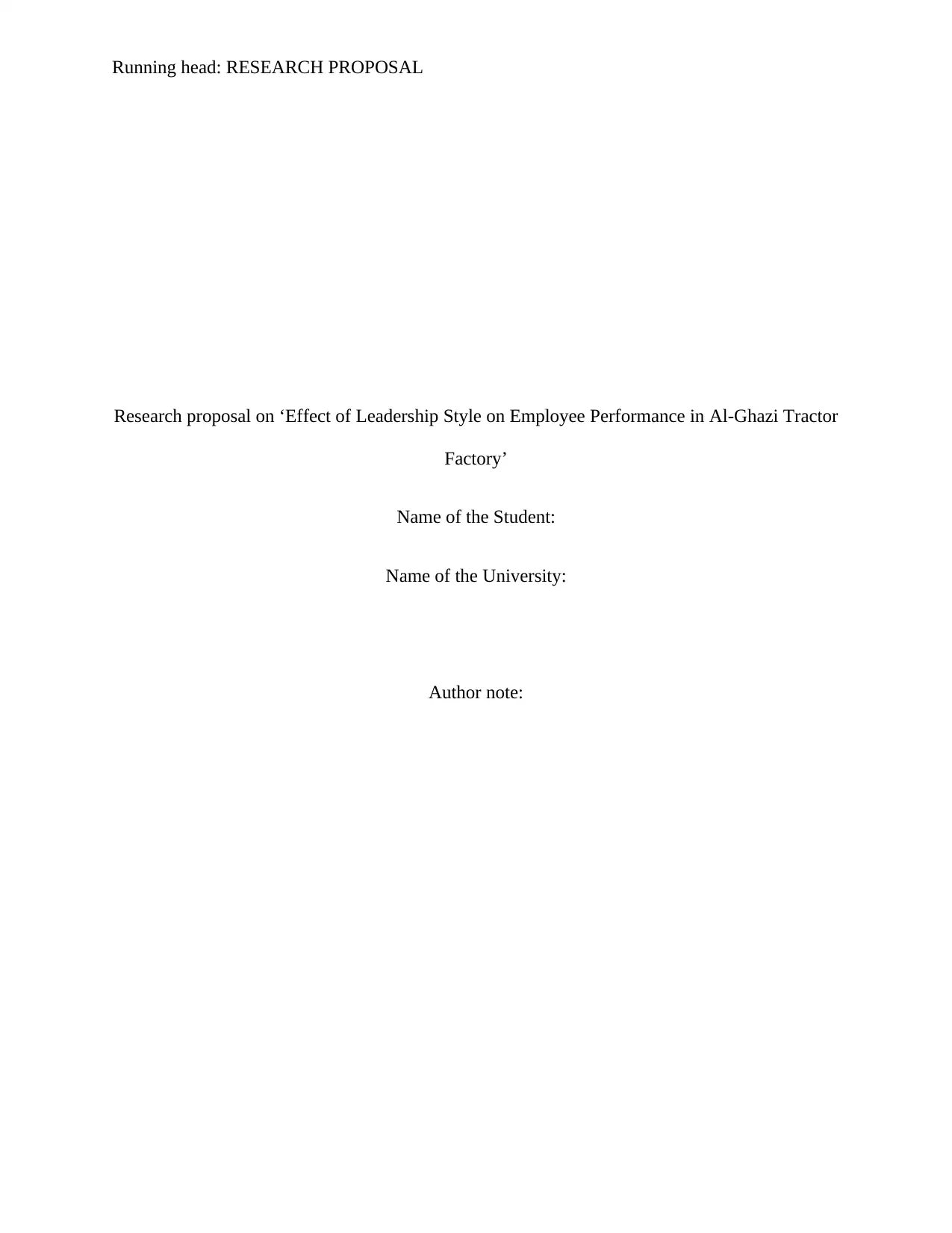
Running head: RESEARCH PROPOSAL
Research proposal on ‘Effect of Leadership Style on Employee Performance in Al-Ghazi Tractor
Factory’
Name of the Student:
Name of the University:
Author note:
Research proposal on ‘Effect of Leadership Style on Employee Performance in Al-Ghazi Tractor
Factory’
Name of the Student:
Name of the University:
Author note:
Paraphrase This Document
Need a fresh take? Get an instant paraphrase of this document with our AI Paraphraser
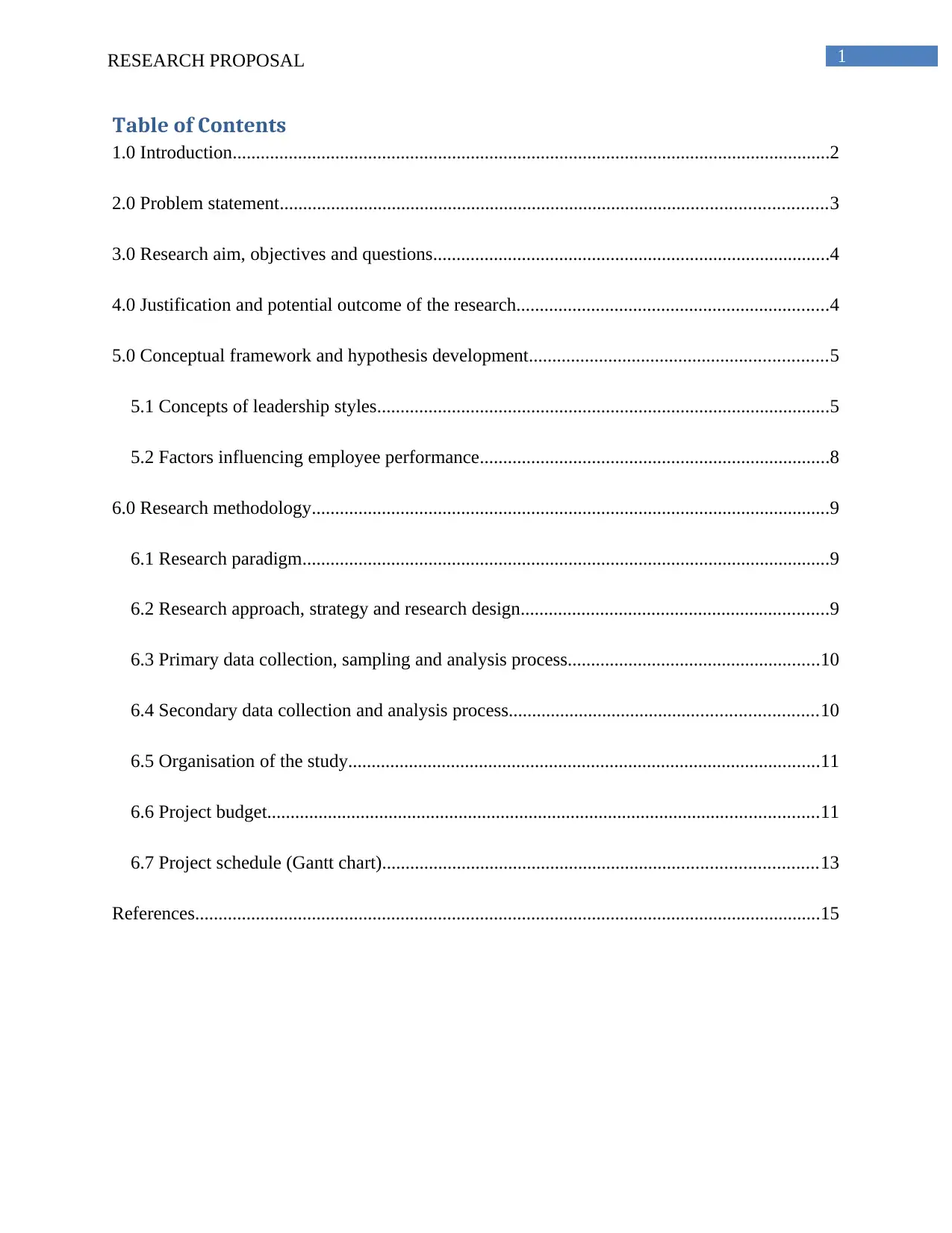
1RESEARCH PROPOSAL
Table of Contents
1.0 Introduction................................................................................................................................2
2.0 Problem statement.....................................................................................................................3
3.0 Research aim, objectives and questions.....................................................................................4
4.0 Justification and potential outcome of the research...................................................................4
5.0 Conceptual framework and hypothesis development................................................................5
5.1 Concepts of leadership styles.................................................................................................5
5.2 Factors influencing employee performance...........................................................................8
6.0 Research methodology...............................................................................................................9
6.1 Research paradigm.................................................................................................................9
6.2 Research approach, strategy and research design..................................................................9
6.3 Primary data collection, sampling and analysis process......................................................10
6.4 Secondary data collection and analysis process..................................................................10
6.5 Organisation of the study.....................................................................................................11
6.6 Project budget......................................................................................................................11
6.7 Project schedule (Gantt chart).............................................................................................13
References......................................................................................................................................15
Table of Contents
1.0 Introduction................................................................................................................................2
2.0 Problem statement.....................................................................................................................3
3.0 Research aim, objectives and questions.....................................................................................4
4.0 Justification and potential outcome of the research...................................................................4
5.0 Conceptual framework and hypothesis development................................................................5
5.1 Concepts of leadership styles.................................................................................................5
5.2 Factors influencing employee performance...........................................................................8
6.0 Research methodology...............................................................................................................9
6.1 Research paradigm.................................................................................................................9
6.2 Research approach, strategy and research design..................................................................9
6.3 Primary data collection, sampling and analysis process......................................................10
6.4 Secondary data collection and analysis process..................................................................10
6.5 Organisation of the study.....................................................................................................11
6.6 Project budget......................................................................................................................11
6.7 Project schedule (Gantt chart).............................................................................................13
References......................................................................................................................................15
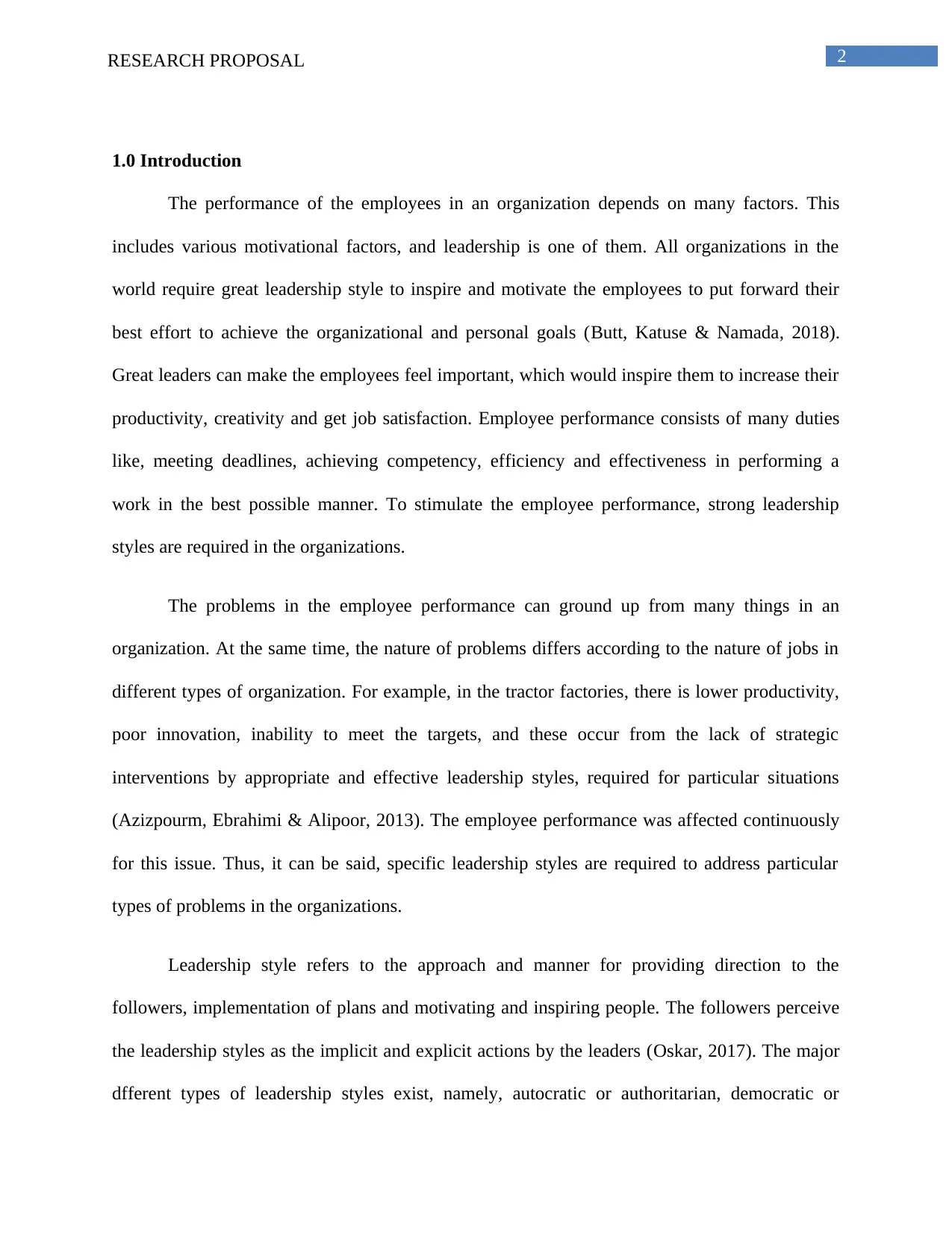
2RESEARCH PROPOSAL
1.0 Introduction
The performance of the employees in an organization depends on many factors. This
includes various motivational factors, and leadership is one of them. All organizations in the
world require great leadership style to inspire and motivate the employees to put forward their
best effort to achieve the organizational and personal goals (Butt, Katuse & Namada, 2018).
Great leaders can make the employees feel important, which would inspire them to increase their
productivity, creativity and get job satisfaction. Employee performance consists of many duties
like, meeting deadlines, achieving competency, efficiency and effectiveness in performing a
work in the best possible manner. To stimulate the employee performance, strong leadership
styles are required in the organizations.
The problems in the employee performance can ground up from many things in an
organization. At the same time, the nature of problems differs according to the nature of jobs in
different types of organization. For example, in the tractor factories, there is lower productivity,
poor innovation, inability to meet the targets, and these occur from the lack of strategic
interventions by appropriate and effective leadership styles, required for particular situations
(Azizpourm, Ebrahimi & Alipoor, 2013). The employee performance was affected continuously
for this issue. Thus, it can be said, specific leadership styles are required to address particular
types of problems in the organizations.
Leadership style refers to the approach and manner for providing direction to the
followers, implementation of plans and motivating and inspiring people. The followers perceive
the leadership styles as the implicit and explicit actions by the leaders (Oskar, 2017). The major
dfferent types of leadership styles exist, namely, autocratic or authoritarian, democratic or
1.0 Introduction
The performance of the employees in an organization depends on many factors. This
includes various motivational factors, and leadership is one of them. All organizations in the
world require great leadership style to inspire and motivate the employees to put forward their
best effort to achieve the organizational and personal goals (Butt, Katuse & Namada, 2018).
Great leaders can make the employees feel important, which would inspire them to increase their
productivity, creativity and get job satisfaction. Employee performance consists of many duties
like, meeting deadlines, achieving competency, efficiency and effectiveness in performing a
work in the best possible manner. To stimulate the employee performance, strong leadership
styles are required in the organizations.
The problems in the employee performance can ground up from many things in an
organization. At the same time, the nature of problems differs according to the nature of jobs in
different types of organization. For example, in the tractor factories, there is lower productivity,
poor innovation, inability to meet the targets, and these occur from the lack of strategic
interventions by appropriate and effective leadership styles, required for particular situations
(Azizpourm, Ebrahimi & Alipoor, 2013). The employee performance was affected continuously
for this issue. Thus, it can be said, specific leadership styles are required to address particular
types of problems in the organizations.
Leadership style refers to the approach and manner for providing direction to the
followers, implementation of plans and motivating and inspiring people. The followers perceive
the leadership styles as the implicit and explicit actions by the leaders (Oskar, 2017). The major
dfferent types of leadership styles exist, namely, autocratic or authoritarian, democratic or
⊘ This is a preview!⊘
Do you want full access?
Subscribe today to unlock all pages.

Trusted by 1+ million students worldwide
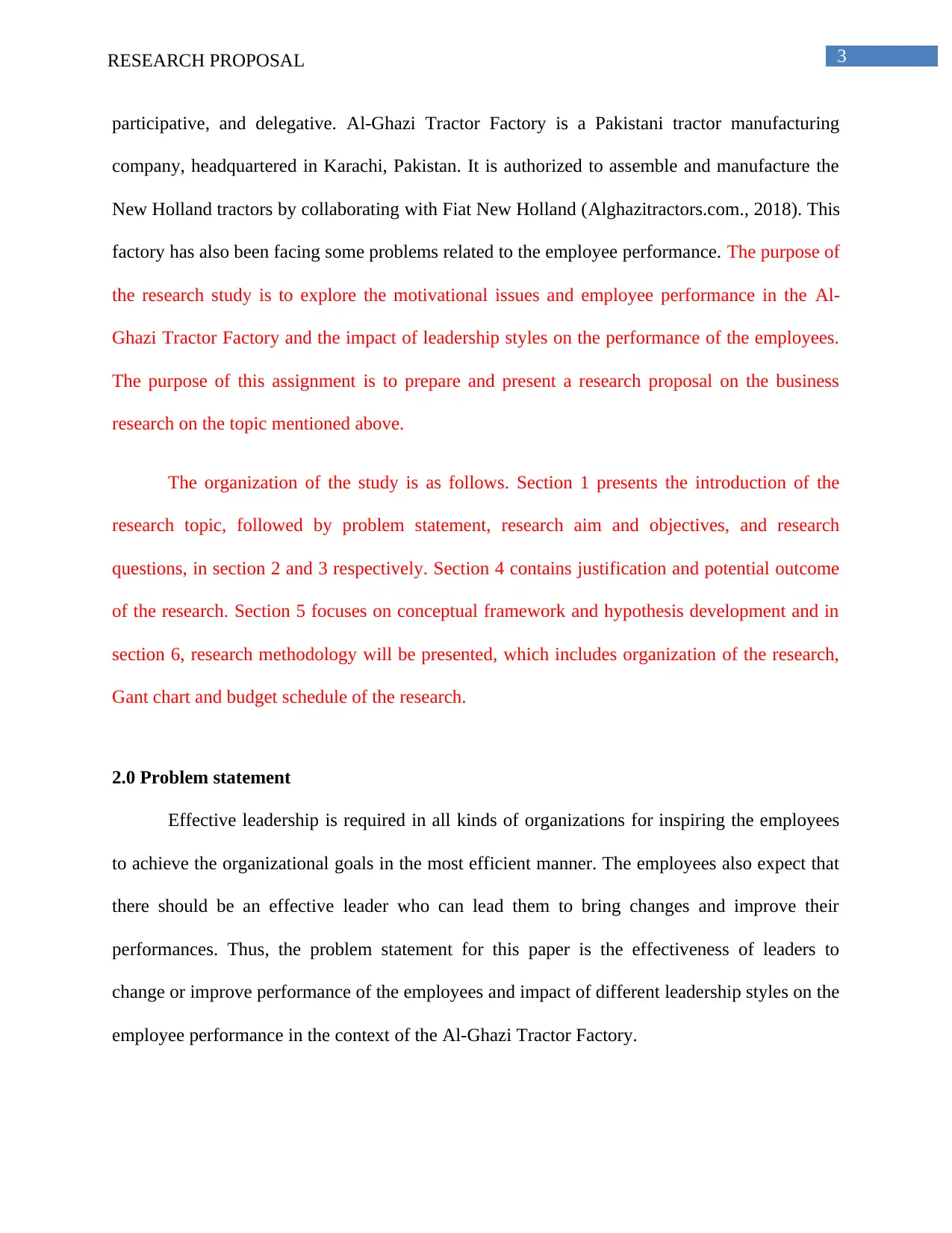
3RESEARCH PROPOSAL
participative, and delegative. Al-Ghazi Tractor Factory is a Pakistani tractor manufacturing
company, headquartered in Karachi, Pakistan. It is authorized to assemble and manufacture the
New Holland tractors by collaborating with Fiat New Holland (Alghazitractors.com., 2018). This
factory has also been facing some problems related to the employee performance. The purpose of
the research study is to explore the motivational issues and employee performance in the Al-
Ghazi Tractor Factory and the impact of leadership styles on the performance of the employees.
The purpose of this assignment is to prepare and present a research proposal on the business
research on the topic mentioned above.
The organization of the study is as follows. Section 1 presents the introduction of the
research topic, followed by problem statement, research aim and objectives, and research
questions, in section 2 and 3 respectively. Section 4 contains justification and potential outcome
of the research. Section 5 focuses on conceptual framework and hypothesis development and in
section 6, research methodology will be presented, which includes organization of the research,
Gant chart and budget schedule of the research.
2.0 Problem statement
Effective leadership is required in all kinds of organizations for inspiring the employees
to achieve the organizational goals in the most efficient manner. The employees also expect that
there should be an effective leader who can lead them to bring changes and improve their
performances. Thus, the problem statement for this paper is the effectiveness of leaders to
change or improve performance of the employees and impact of different leadership styles on the
employee performance in the context of the Al-Ghazi Tractor Factory.
participative, and delegative. Al-Ghazi Tractor Factory is a Pakistani tractor manufacturing
company, headquartered in Karachi, Pakistan. It is authorized to assemble and manufacture the
New Holland tractors by collaborating with Fiat New Holland (Alghazitractors.com., 2018). This
factory has also been facing some problems related to the employee performance. The purpose of
the research study is to explore the motivational issues and employee performance in the Al-
Ghazi Tractor Factory and the impact of leadership styles on the performance of the employees.
The purpose of this assignment is to prepare and present a research proposal on the business
research on the topic mentioned above.
The organization of the study is as follows. Section 1 presents the introduction of the
research topic, followed by problem statement, research aim and objectives, and research
questions, in section 2 and 3 respectively. Section 4 contains justification and potential outcome
of the research. Section 5 focuses on conceptual framework and hypothesis development and in
section 6, research methodology will be presented, which includes organization of the research,
Gant chart and budget schedule of the research.
2.0 Problem statement
Effective leadership is required in all kinds of organizations for inspiring the employees
to achieve the organizational goals in the most efficient manner. The employees also expect that
there should be an effective leader who can lead them to bring changes and improve their
performances. Thus, the problem statement for this paper is the effectiveness of leaders to
change or improve performance of the employees and impact of different leadership styles on the
employee performance in the context of the Al-Ghazi Tractor Factory.
Paraphrase This Document
Need a fresh take? Get an instant paraphrase of this document with our AI Paraphraser
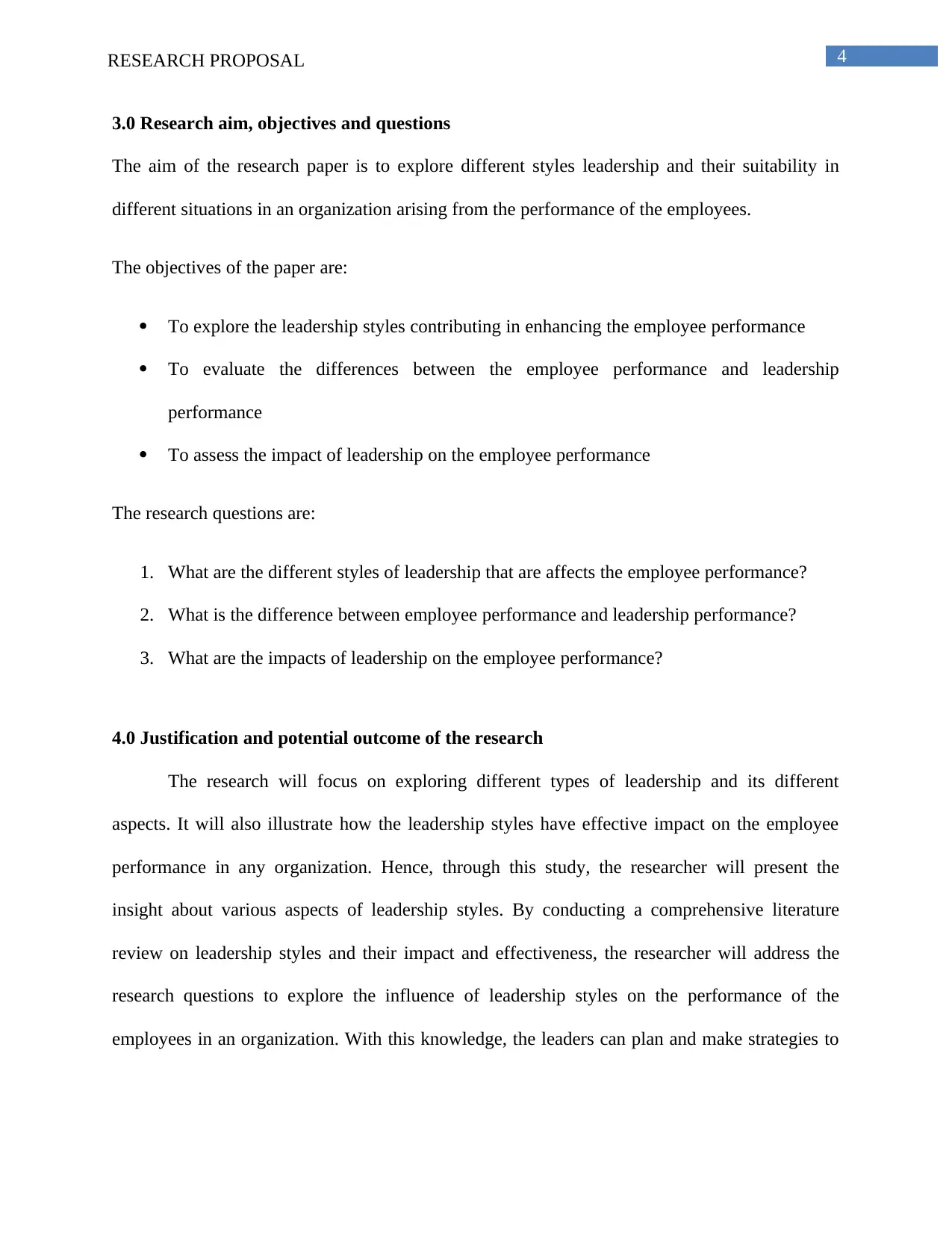
4RESEARCH PROPOSAL
3.0 Research aim, objectives and questions
The aim of the research paper is to explore different styles leadership and their suitability in
different situations in an organization arising from the performance of the employees.
The objectives of the paper are:
To explore the leadership styles contributing in enhancing the employee performance
To evaluate the differences between the employee performance and leadership
performance
To assess the impact of leadership on the employee performance
The research questions are:
1. What are the different styles of leadership that are affects the employee performance?
2. What is the difference between employee performance and leadership performance?
3. What are the impacts of leadership on the employee performance?
4.0 Justification and potential outcome of the research
The research will focus on exploring different types of leadership and its different
aspects. It will also illustrate how the leadership styles have effective impact on the employee
performance in any organization. Hence, through this study, the researcher will present the
insight about various aspects of leadership styles. By conducting a comprehensive literature
review on leadership styles and their impact and effectiveness, the researcher will address the
research questions to explore the influence of leadership styles on the performance of the
employees in an organization. With this knowledge, the leaders can plan and make strategies to
3.0 Research aim, objectives and questions
The aim of the research paper is to explore different styles leadership and their suitability in
different situations in an organization arising from the performance of the employees.
The objectives of the paper are:
To explore the leadership styles contributing in enhancing the employee performance
To evaluate the differences between the employee performance and leadership
performance
To assess the impact of leadership on the employee performance
The research questions are:
1. What are the different styles of leadership that are affects the employee performance?
2. What is the difference between employee performance and leadership performance?
3. What are the impacts of leadership on the employee performance?
4.0 Justification and potential outcome of the research
The research will focus on exploring different types of leadership and its different
aspects. It will also illustrate how the leadership styles have effective impact on the employee
performance in any organization. Hence, through this study, the researcher will present the
insight about various aspects of leadership styles. By conducting a comprehensive literature
review on leadership styles and their impact and effectiveness, the researcher will address the
research questions to explore the influence of leadership styles on the performance of the
employees in an organization. With this knowledge, the leaders can plan and make strategies to
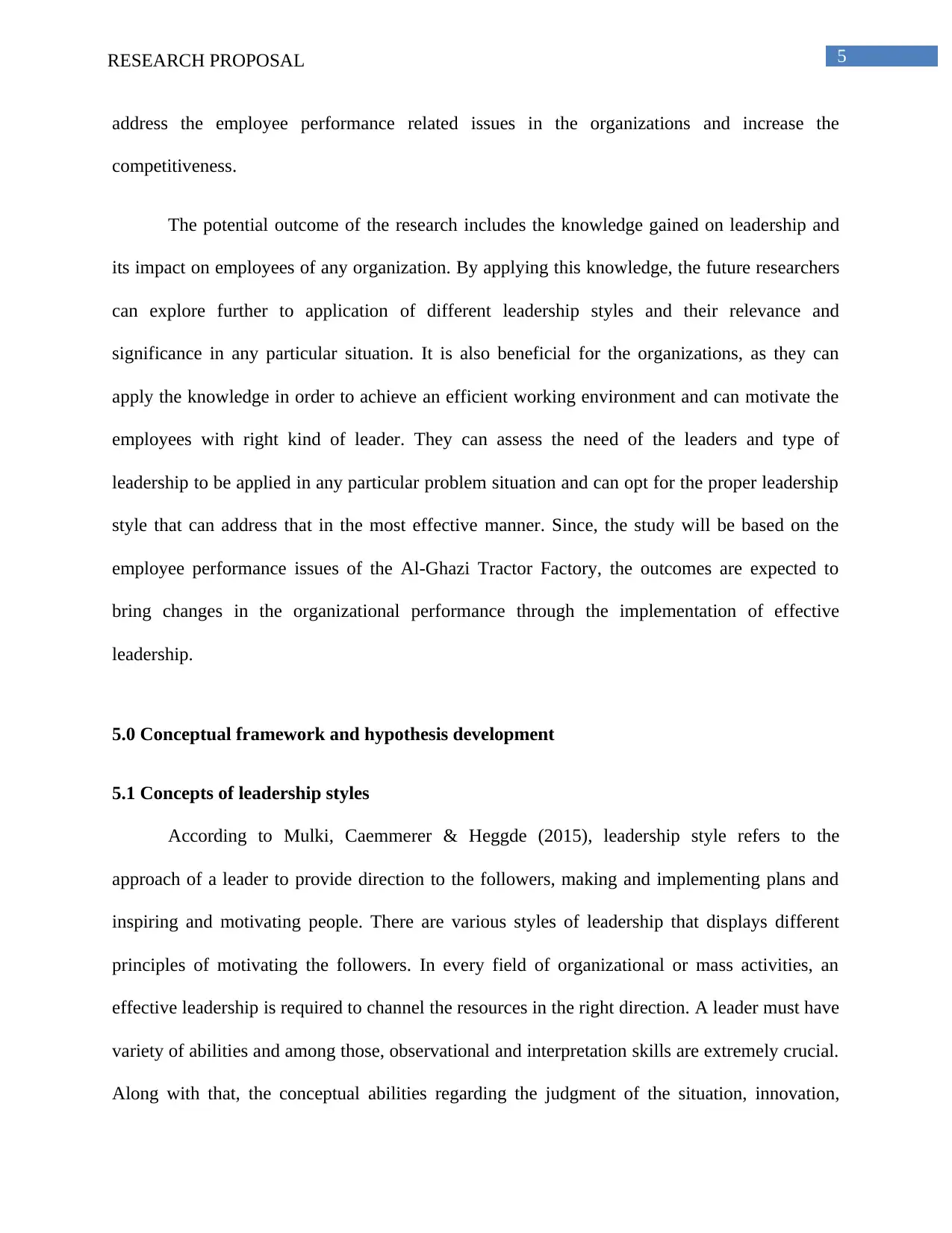
5RESEARCH PROPOSAL
address the employee performance related issues in the organizations and increase the
competitiveness.
The potential outcome of the research includes the knowledge gained on leadership and
its impact on employees of any organization. By applying this knowledge, the future researchers
can explore further to application of different leadership styles and their relevance and
significance in any particular situation. It is also beneficial for the organizations, as they can
apply the knowledge in order to achieve an efficient working environment and can motivate the
employees with right kind of leader. They can assess the need of the leaders and type of
leadership to be applied in any particular problem situation and can opt for the proper leadership
style that can address that in the most effective manner. Since, the study will be based on the
employee performance issues of the Al-Ghazi Tractor Factory, the outcomes are expected to
bring changes in the organizational performance through the implementation of effective
leadership.
5.0 Conceptual framework and hypothesis development
5.1 Concepts of leadership styles
According to Mulki, Caemmerer & Heggde (2015), leadership style refers to the
approach of a leader to provide direction to the followers, making and implementing plans and
inspiring and motivating people. There are various styles of leadership that displays different
principles of motivating the followers. In every field of organizational or mass activities, an
effective leadership is required to channel the resources in the right direction. A leader must have
variety of abilities and among those, observational and interpretation skills are extremely crucial.
Along with that, the conceptual abilities regarding the judgment of the situation, innovation,
address the employee performance related issues in the organizations and increase the
competitiveness.
The potential outcome of the research includes the knowledge gained on leadership and
its impact on employees of any organization. By applying this knowledge, the future researchers
can explore further to application of different leadership styles and their relevance and
significance in any particular situation. It is also beneficial for the organizations, as they can
apply the knowledge in order to achieve an efficient working environment and can motivate the
employees with right kind of leader. They can assess the need of the leaders and type of
leadership to be applied in any particular problem situation and can opt for the proper leadership
style that can address that in the most effective manner. Since, the study will be based on the
employee performance issues of the Al-Ghazi Tractor Factory, the outcomes are expected to
bring changes in the organizational performance through the implementation of effective
leadership.
5.0 Conceptual framework and hypothesis development
5.1 Concepts of leadership styles
According to Mulki, Caemmerer & Heggde (2015), leadership style refers to the
approach of a leader to provide direction to the followers, making and implementing plans and
inspiring and motivating people. There are various styles of leadership that displays different
principles of motivating the followers. In every field of organizational or mass activities, an
effective leadership is required to channel the resources in the right direction. A leader must have
variety of abilities and among those, observational and interpretation skills are extremely crucial.
Along with that, the conceptual abilities regarding the judgment of the situation, innovation,
⊘ This is a preview!⊘
Do you want full access?
Subscribe today to unlock all pages.

Trusted by 1+ million students worldwide
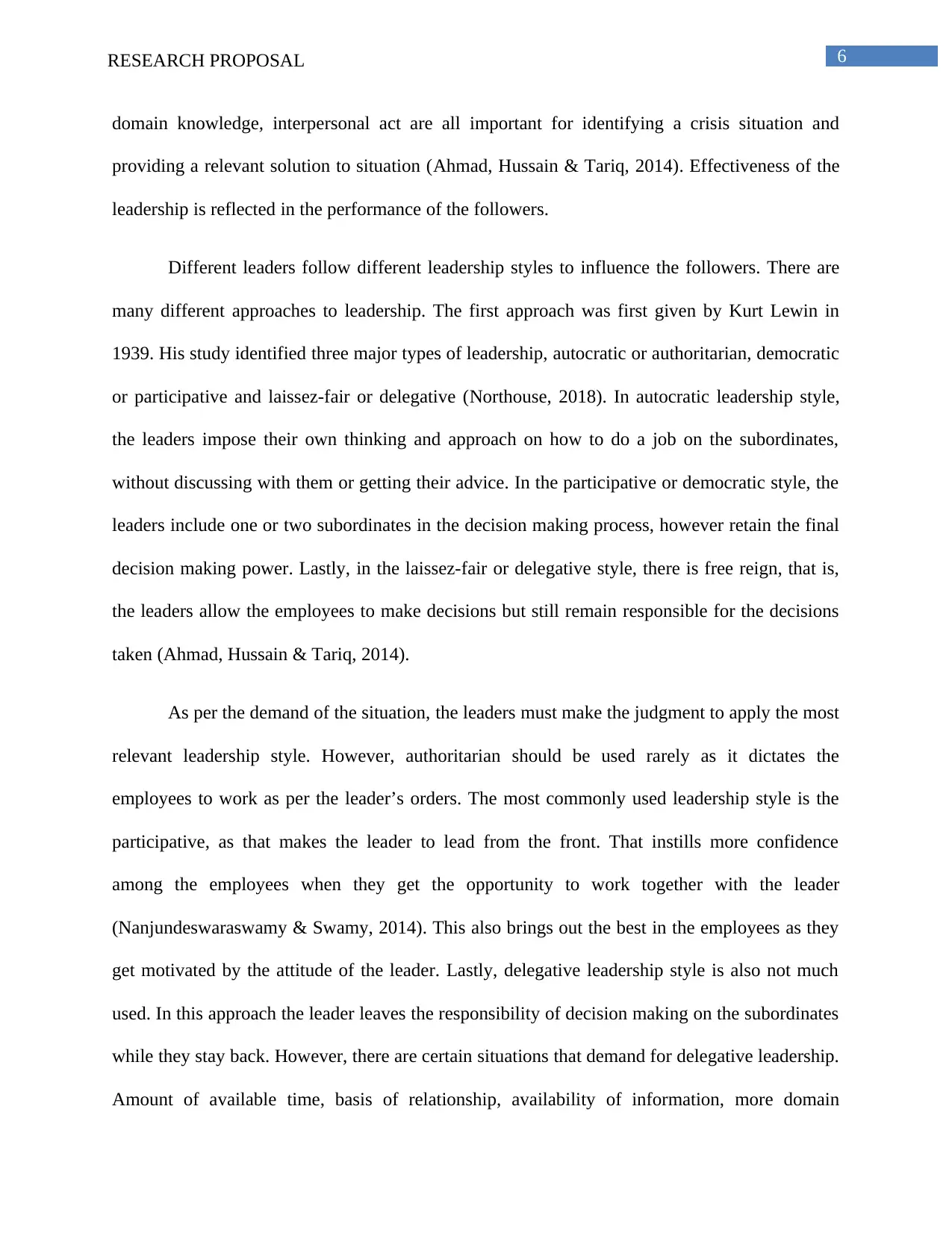
6RESEARCH PROPOSAL
domain knowledge, interpersonal act are all important for identifying a crisis situation and
providing a relevant solution to situation (Ahmad, Hussain & Tariq, 2014). Effectiveness of the
leadership is reflected in the performance of the followers.
Different leaders follow different leadership styles to influence the followers. There are
many different approaches to leadership. The first approach was first given by Kurt Lewin in
1939. His study identified three major types of leadership, autocratic or authoritarian, democratic
or participative and laissez-fair or delegative (Northouse, 2018). In autocratic leadership style,
the leaders impose their own thinking and approach on how to do a job on the subordinates,
without discussing with them or getting their advice. In the participative or democratic style, the
leaders include one or two subordinates in the decision making process, however retain the final
decision making power. Lastly, in the laissez-fair or delegative style, there is free reign, that is,
the leaders allow the employees to make decisions but still remain responsible for the decisions
taken (Ahmad, Hussain & Tariq, 2014).
As per the demand of the situation, the leaders must make the judgment to apply the most
relevant leadership style. However, authoritarian should be used rarely as it dictates the
employees to work as per the leader’s orders. The most commonly used leadership style is the
participative, as that makes the leader to lead from the front. That instills more confidence
among the employees when they get the opportunity to work together with the leader
(Nanjundeswaraswamy & Swamy, 2014). This also brings out the best in the employees as they
get motivated by the attitude of the leader. Lastly, delegative leadership style is also not much
used. In this approach the leader leaves the responsibility of decision making on the subordinates
while they stay back. However, there are certain situations that demand for delegative leadership.
Amount of available time, basis of relationship, availability of information, more domain
domain knowledge, interpersonal act are all important for identifying a crisis situation and
providing a relevant solution to situation (Ahmad, Hussain & Tariq, 2014). Effectiveness of the
leadership is reflected in the performance of the followers.
Different leaders follow different leadership styles to influence the followers. There are
many different approaches to leadership. The first approach was first given by Kurt Lewin in
1939. His study identified three major types of leadership, autocratic or authoritarian, democratic
or participative and laissez-fair or delegative (Northouse, 2018). In autocratic leadership style,
the leaders impose their own thinking and approach on how to do a job on the subordinates,
without discussing with them or getting their advice. In the participative or democratic style, the
leaders include one or two subordinates in the decision making process, however retain the final
decision making power. Lastly, in the laissez-fair or delegative style, there is free reign, that is,
the leaders allow the employees to make decisions but still remain responsible for the decisions
taken (Ahmad, Hussain & Tariq, 2014).
As per the demand of the situation, the leaders must make the judgment to apply the most
relevant leadership style. However, authoritarian should be used rarely as it dictates the
employees to work as per the leader’s orders. The most commonly used leadership style is the
participative, as that makes the leader to lead from the front. That instills more confidence
among the employees when they get the opportunity to work together with the leader
(Nanjundeswaraswamy & Swamy, 2014). This also brings out the best in the employees as they
get motivated by the attitude of the leader. Lastly, delegative leadership style is also not much
used. In this approach the leader leaves the responsibility of decision making on the subordinates
while they stay back. However, there are certain situations that demand for delegative leadership.
Amount of available time, basis of relationship, availability of information, more domain
Paraphrase This Document
Need a fresh take? Get an instant paraphrase of this document with our AI Paraphraser
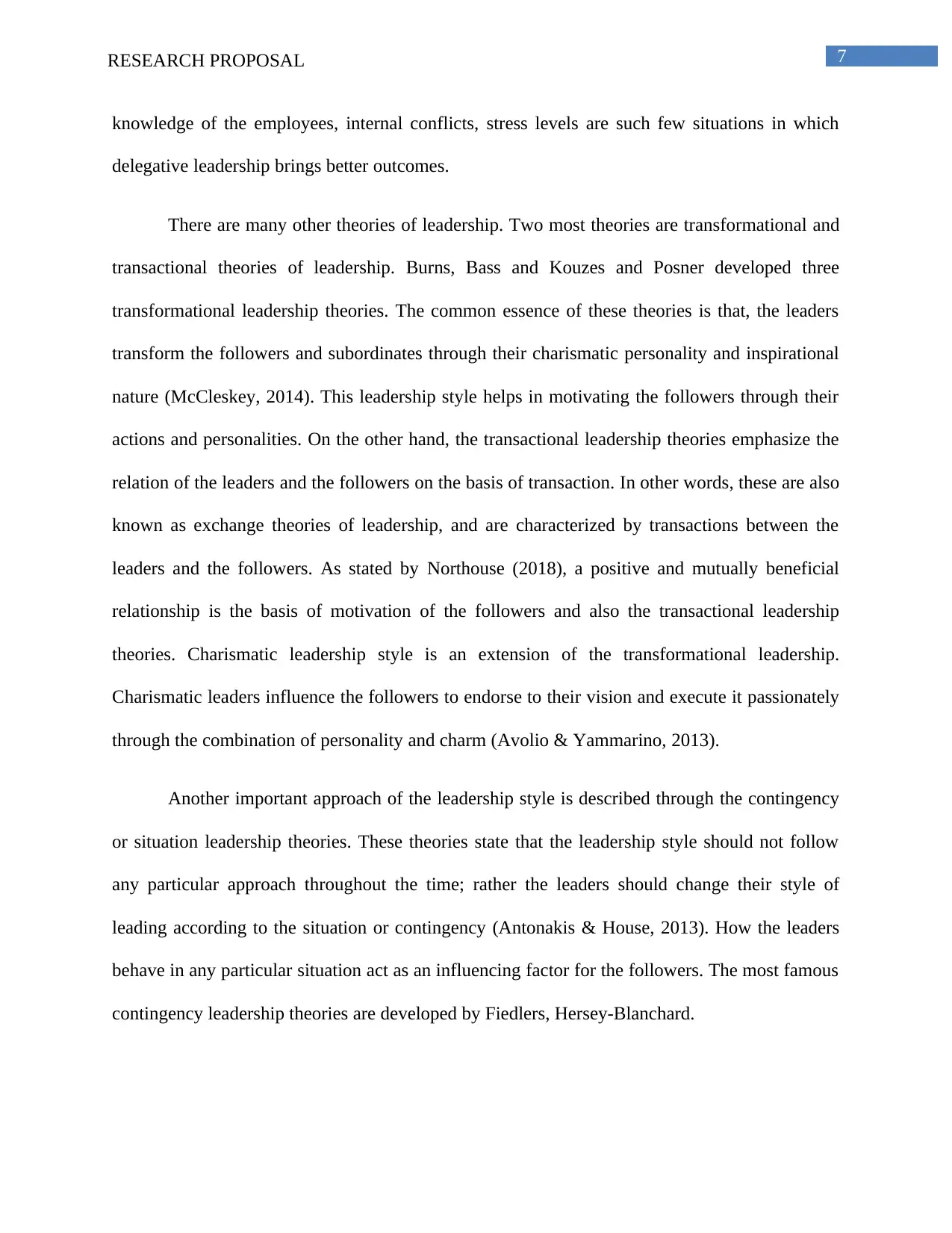
7RESEARCH PROPOSAL
knowledge of the employees, internal conflicts, stress levels are such few situations in which
delegative leadership brings better outcomes.
There are many other theories of leadership. Two most theories are transformational and
transactional theories of leadership. Burns, Bass and Kouzes and Posner developed three
transformational leadership theories. The common essence of these theories is that, the leaders
transform the followers and subordinates through their charismatic personality and inspirational
nature (McCleskey, 2014). This leadership style helps in motivating the followers through their
actions and personalities. On the other hand, the transactional leadership theories emphasize the
relation of the leaders and the followers on the basis of transaction. In other words, these are also
known as exchange theories of leadership, and are characterized by transactions between the
leaders and the followers. As stated by Northouse (2018), a positive and mutually beneficial
relationship is the basis of motivation of the followers and also the transactional leadership
theories. Charismatic leadership style is an extension of the transformational leadership.
Charismatic leaders influence the followers to endorse to their vision and execute it passionately
through the combination of personality and charm (Avolio & Yammarino, 2013).
Another important approach of the leadership style is described through the contingency
or situation leadership theories. These theories state that the leadership style should not follow
any particular approach throughout the time; rather the leaders should change their style of
leading according to the situation or contingency (Antonakis & House, 2013). How the leaders
behave in any particular situation act as an influencing factor for the followers. The most famous
contingency leadership theories are developed by Fiedlers, Hersey-Blanchard.
knowledge of the employees, internal conflicts, stress levels are such few situations in which
delegative leadership brings better outcomes.
There are many other theories of leadership. Two most theories are transformational and
transactional theories of leadership. Burns, Bass and Kouzes and Posner developed three
transformational leadership theories. The common essence of these theories is that, the leaders
transform the followers and subordinates through their charismatic personality and inspirational
nature (McCleskey, 2014). This leadership style helps in motivating the followers through their
actions and personalities. On the other hand, the transactional leadership theories emphasize the
relation of the leaders and the followers on the basis of transaction. In other words, these are also
known as exchange theories of leadership, and are characterized by transactions between the
leaders and the followers. As stated by Northouse (2018), a positive and mutually beneficial
relationship is the basis of motivation of the followers and also the transactional leadership
theories. Charismatic leadership style is an extension of the transformational leadership.
Charismatic leaders influence the followers to endorse to their vision and execute it passionately
through the combination of personality and charm (Avolio & Yammarino, 2013).
Another important approach of the leadership style is described through the contingency
or situation leadership theories. These theories state that the leadership style should not follow
any particular approach throughout the time; rather the leaders should change their style of
leading according to the situation or contingency (Antonakis & House, 2013). How the leaders
behave in any particular situation act as an influencing factor for the followers. The most famous
contingency leadership theories are developed by Fiedlers, Hersey-Blanchard.
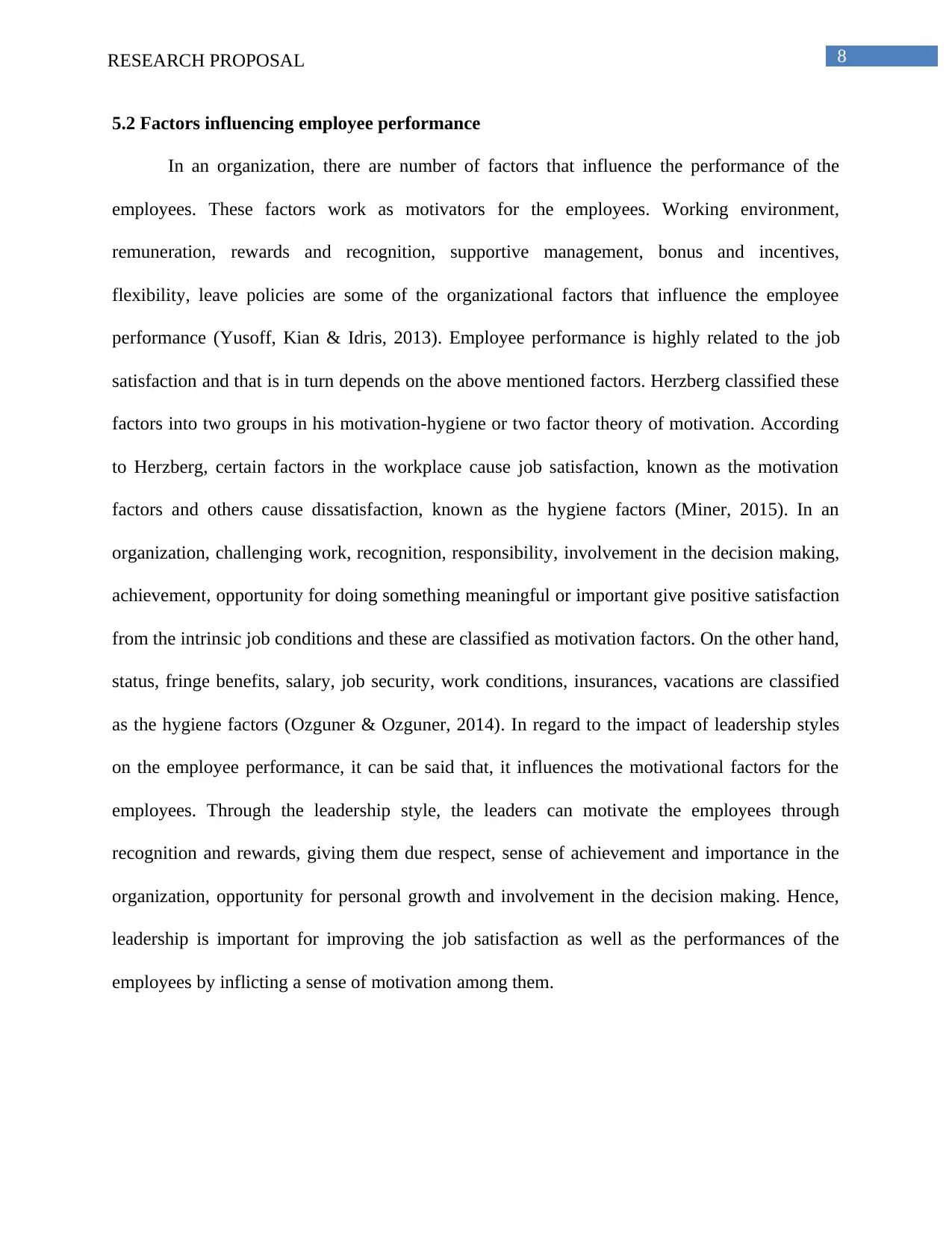
8RESEARCH PROPOSAL
5.2 Factors influencing employee performance
In an organization, there are number of factors that influence the performance of the
employees. These factors work as motivators for the employees. Working environment,
remuneration, rewards and recognition, supportive management, bonus and incentives,
flexibility, leave policies are some of the organizational factors that influence the employee
performance (Yusoff, Kian & Idris, 2013). Employee performance is highly related to the job
satisfaction and that is in turn depends on the above mentioned factors. Herzberg classified these
factors into two groups in his motivation-hygiene or two factor theory of motivation. According
to Herzberg, certain factors in the workplace cause job satisfaction, known as the motivation
factors and others cause dissatisfaction, known as the hygiene factors (Miner, 2015). In an
organization, challenging work, recognition, responsibility, involvement in the decision making,
achievement, opportunity for doing something meaningful or important give positive satisfaction
from the intrinsic job conditions and these are classified as motivation factors. On the other hand,
status, fringe benefits, salary, job security, work conditions, insurances, vacations are classified
as the hygiene factors (Ozguner & Ozguner, 2014). In regard to the impact of leadership styles
on the employee performance, it can be said that, it influences the motivational factors for the
employees. Through the leadership style, the leaders can motivate the employees through
recognition and rewards, giving them due respect, sense of achievement and importance in the
organization, opportunity for personal growth and involvement in the decision making. Hence,
leadership is important for improving the job satisfaction as well as the performances of the
employees by inflicting a sense of motivation among them.
5.2 Factors influencing employee performance
In an organization, there are number of factors that influence the performance of the
employees. These factors work as motivators for the employees. Working environment,
remuneration, rewards and recognition, supportive management, bonus and incentives,
flexibility, leave policies are some of the organizational factors that influence the employee
performance (Yusoff, Kian & Idris, 2013). Employee performance is highly related to the job
satisfaction and that is in turn depends on the above mentioned factors. Herzberg classified these
factors into two groups in his motivation-hygiene or two factor theory of motivation. According
to Herzberg, certain factors in the workplace cause job satisfaction, known as the motivation
factors and others cause dissatisfaction, known as the hygiene factors (Miner, 2015). In an
organization, challenging work, recognition, responsibility, involvement in the decision making,
achievement, opportunity for doing something meaningful or important give positive satisfaction
from the intrinsic job conditions and these are classified as motivation factors. On the other hand,
status, fringe benefits, salary, job security, work conditions, insurances, vacations are classified
as the hygiene factors (Ozguner & Ozguner, 2014). In regard to the impact of leadership styles
on the employee performance, it can be said that, it influences the motivational factors for the
employees. Through the leadership style, the leaders can motivate the employees through
recognition and rewards, giving them due respect, sense of achievement and importance in the
organization, opportunity for personal growth and involvement in the decision making. Hence,
leadership is important for improving the job satisfaction as well as the performances of the
employees by inflicting a sense of motivation among them.
⊘ This is a preview!⊘
Do you want full access?
Subscribe today to unlock all pages.

Trusted by 1+ million students worldwide
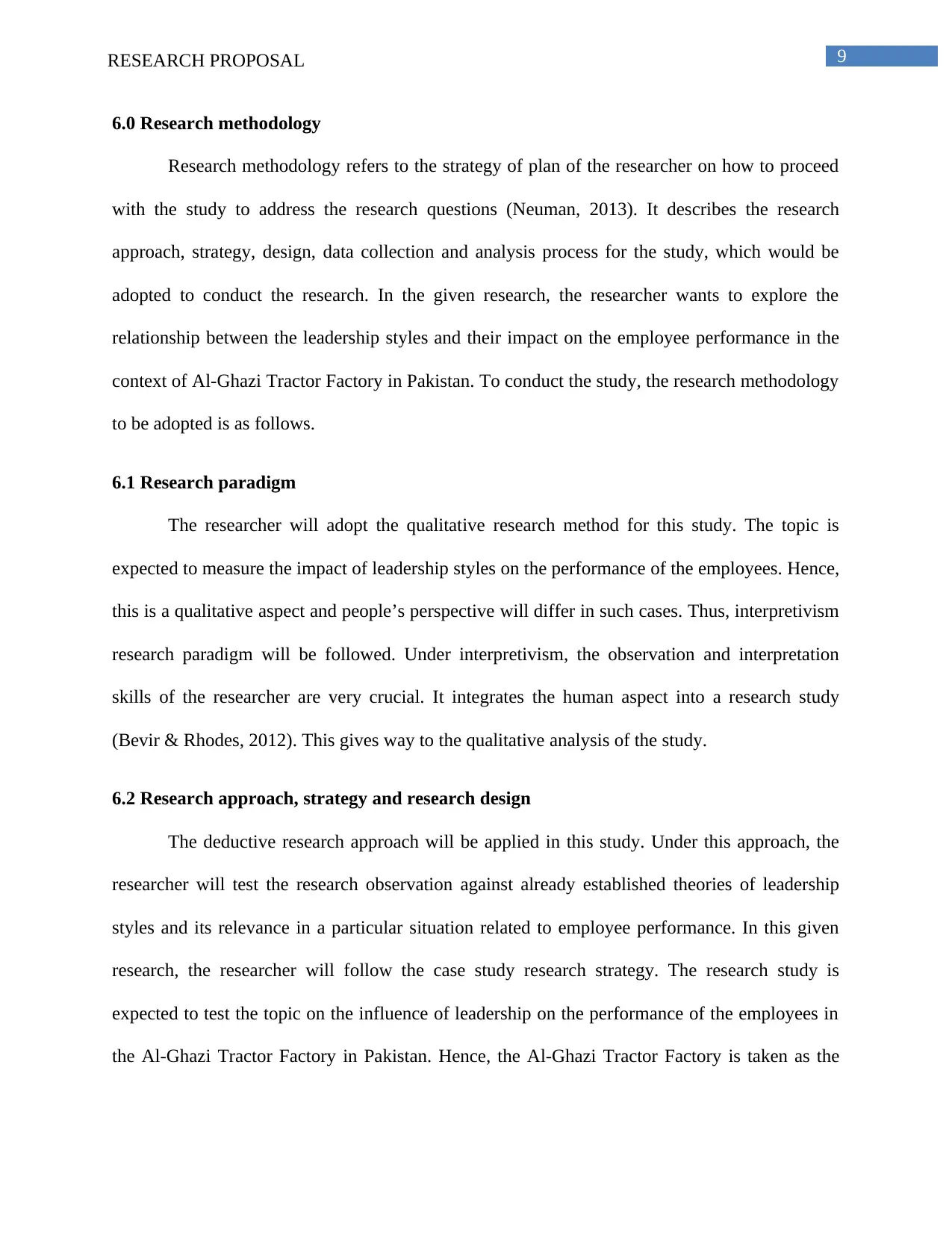
9RESEARCH PROPOSAL
6.0 Research methodology
Research methodology refers to the strategy of plan of the researcher on how to proceed
with the study to address the research questions (Neuman, 2013). It describes the research
approach, strategy, design, data collection and analysis process for the study, which would be
adopted to conduct the research. In the given research, the researcher wants to explore the
relationship between the leadership styles and their impact on the employee performance in the
context of Al-Ghazi Tractor Factory in Pakistan. To conduct the study, the research methodology
to be adopted is as follows.
6.1 Research paradigm
The researcher will adopt the qualitative research method for this study. The topic is
expected to measure the impact of leadership styles on the performance of the employees. Hence,
this is a qualitative aspect and people’s perspective will differ in such cases. Thus, interpretivism
research paradigm will be followed. Under interpretivism, the observation and interpretation
skills of the researcher are very crucial. It integrates the human aspect into a research study
(Bevir & Rhodes, 2012). This gives way to the qualitative analysis of the study.
6.2 Research approach, strategy and research design
The deductive research approach will be applied in this study. Under this approach, the
researcher will test the research observation against already established theories of leadership
styles and its relevance in a particular situation related to employee performance. In this given
research, the researcher will follow the case study research strategy. The research study is
expected to test the topic on the influence of leadership on the performance of the employees in
the Al-Ghazi Tractor Factory in Pakistan. Hence, the Al-Ghazi Tractor Factory is taken as the
6.0 Research methodology
Research methodology refers to the strategy of plan of the researcher on how to proceed
with the study to address the research questions (Neuman, 2013). It describes the research
approach, strategy, design, data collection and analysis process for the study, which would be
adopted to conduct the research. In the given research, the researcher wants to explore the
relationship between the leadership styles and their impact on the employee performance in the
context of Al-Ghazi Tractor Factory in Pakistan. To conduct the study, the research methodology
to be adopted is as follows.
6.1 Research paradigm
The researcher will adopt the qualitative research method for this study. The topic is
expected to measure the impact of leadership styles on the performance of the employees. Hence,
this is a qualitative aspect and people’s perspective will differ in such cases. Thus, interpretivism
research paradigm will be followed. Under interpretivism, the observation and interpretation
skills of the researcher are very crucial. It integrates the human aspect into a research study
(Bevir & Rhodes, 2012). This gives way to the qualitative analysis of the study.
6.2 Research approach, strategy and research design
The deductive research approach will be applied in this study. Under this approach, the
researcher will test the research observation against already established theories of leadership
styles and its relevance in a particular situation related to employee performance. In this given
research, the researcher will follow the case study research strategy. The research study is
expected to test the topic on the influence of leadership on the performance of the employees in
the Al-Ghazi Tractor Factory in Pakistan. Hence, the Al-Ghazi Tractor Factory is taken as the
Paraphrase This Document
Need a fresh take? Get an instant paraphrase of this document with our AI Paraphraser
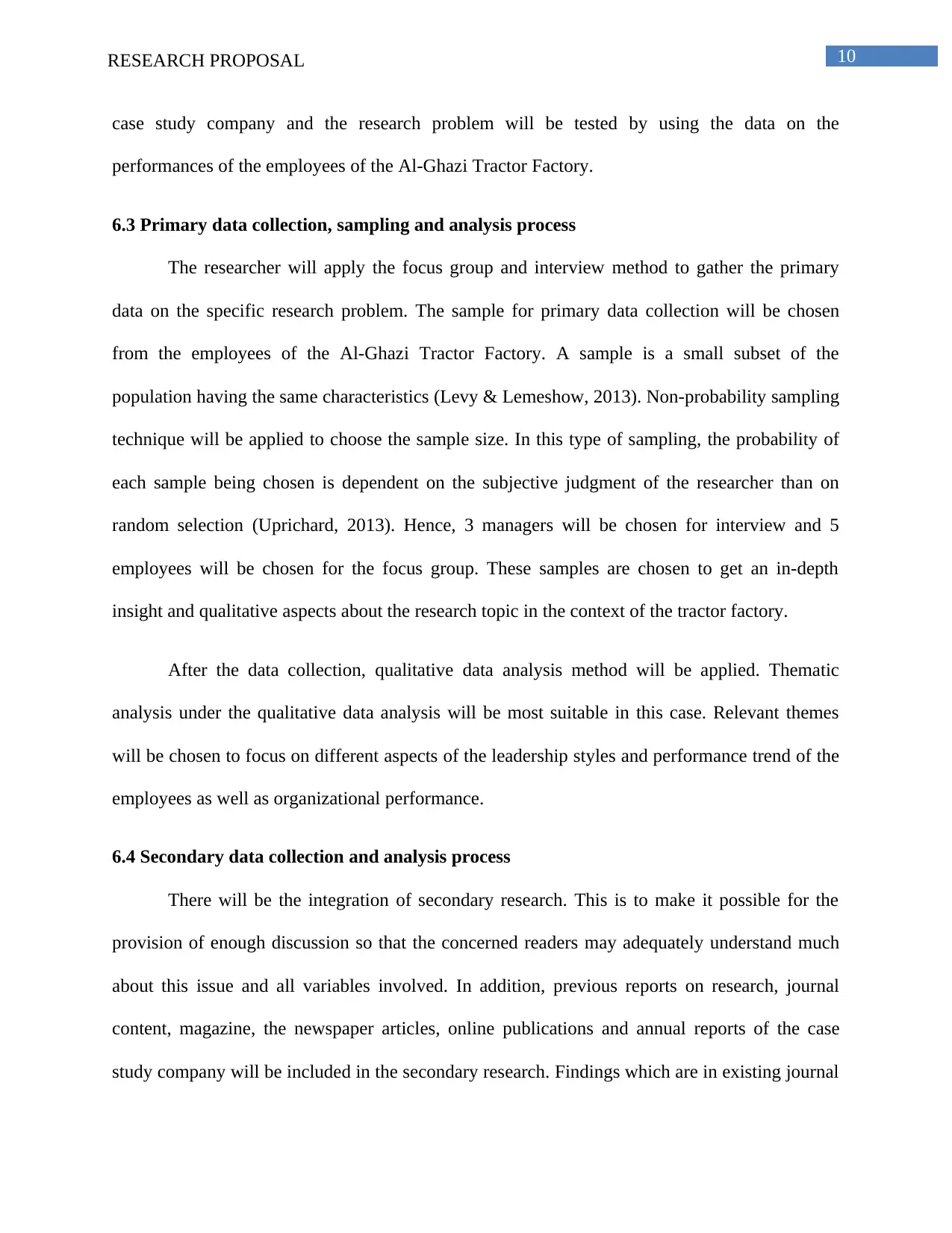
10RESEARCH PROPOSAL
case study company and the research problem will be tested by using the data on the
performances of the employees of the Al-Ghazi Tractor Factory.
6.3 Primary data collection, sampling and analysis process
The researcher will apply the focus group and interview method to gather the primary
data on the specific research problem. The sample for primary data collection will be chosen
from the employees of the Al-Ghazi Tractor Factory. A sample is a small subset of the
population having the same characteristics (Levy & Lemeshow, 2013). Non-probability sampling
technique will be applied to choose the sample size. In this type of sampling, the probability of
each sample being chosen is dependent on the subjective judgment of the researcher than on
random selection (Uprichard, 2013). Hence, 3 managers will be chosen for interview and 5
employees will be chosen for the focus group. These samples are chosen to get an in-depth
insight and qualitative aspects about the research topic in the context of the tractor factory.
After the data collection, qualitative data analysis method will be applied. Thematic
analysis under the qualitative data analysis will be most suitable in this case. Relevant themes
will be chosen to focus on different aspects of the leadership styles and performance trend of the
employees as well as organizational performance.
6.4 Secondary data collection and analysis process
There will be the integration of secondary research. This is to make it possible for the
provision of enough discussion so that the concerned readers may adequately understand much
about this issue and all variables involved. In addition, previous reports on research, journal
content, magazine, the newspaper articles, online publications and annual reports of the case
study company will be included in the secondary research. Findings which are in existing journal
case study company and the research problem will be tested by using the data on the
performances of the employees of the Al-Ghazi Tractor Factory.
6.3 Primary data collection, sampling and analysis process
The researcher will apply the focus group and interview method to gather the primary
data on the specific research problem. The sample for primary data collection will be chosen
from the employees of the Al-Ghazi Tractor Factory. A sample is a small subset of the
population having the same characteristics (Levy & Lemeshow, 2013). Non-probability sampling
technique will be applied to choose the sample size. In this type of sampling, the probability of
each sample being chosen is dependent on the subjective judgment of the researcher than on
random selection (Uprichard, 2013). Hence, 3 managers will be chosen for interview and 5
employees will be chosen for the focus group. These samples are chosen to get an in-depth
insight and qualitative aspects about the research topic in the context of the tractor factory.
After the data collection, qualitative data analysis method will be applied. Thematic
analysis under the qualitative data analysis will be most suitable in this case. Relevant themes
will be chosen to focus on different aspects of the leadership styles and performance trend of the
employees as well as organizational performance.
6.4 Secondary data collection and analysis process
There will be the integration of secondary research. This is to make it possible for the
provision of enough discussion so that the concerned readers may adequately understand much
about this issue and all variables involved. In addition, previous reports on research, journal
content, magazine, the newspaper articles, online publications and annual reports of the case
study company will be included in the secondary research. Findings which are in existing journal
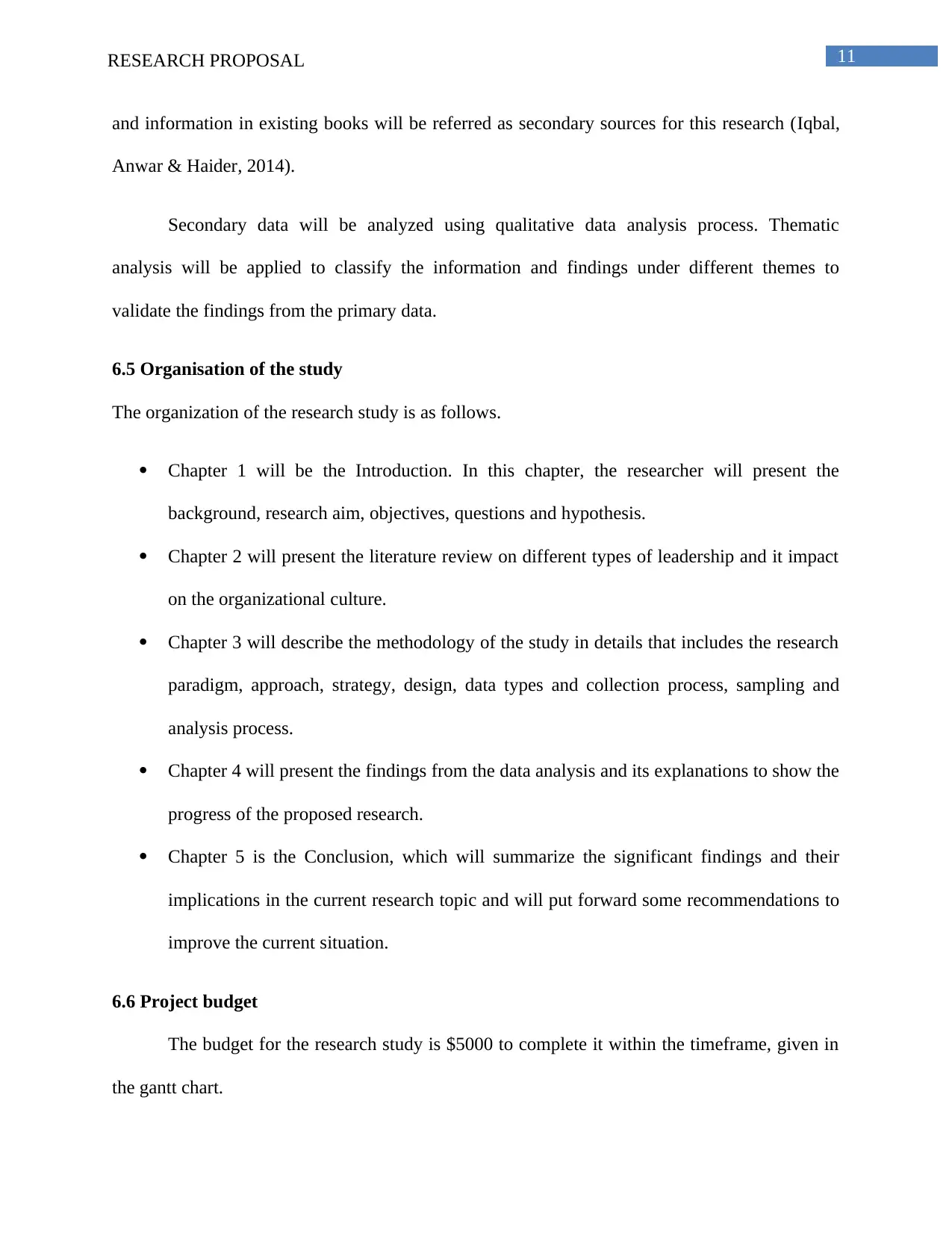
11RESEARCH PROPOSAL
and information in existing books will be referred as secondary sources for this research (Iqbal,
Anwar & Haider, 2014).
Secondary data will be analyzed using qualitative data analysis process. Thematic
analysis will be applied to classify the information and findings under different themes to
validate the findings from the primary data.
6.5 Organisation of the study
The organization of the research study is as follows.
Chapter 1 will be the Introduction. In this chapter, the researcher will present the
background, research aim, objectives, questions and hypothesis.
Chapter 2 will present the literature review on different types of leadership and it impact
on the organizational culture.
Chapter 3 will describe the methodology of the study in details that includes the research
paradigm, approach, strategy, design, data types and collection process, sampling and
analysis process.
Chapter 4 will present the findings from the data analysis and its explanations to show the
progress of the proposed research.
Chapter 5 is the Conclusion, which will summarize the significant findings and their
implications in the current research topic and will put forward some recommendations to
improve the current situation.
6.6 Project budget
The budget for the research study is $5000 to complete it within the timeframe, given in
the gantt chart.
and information in existing books will be referred as secondary sources for this research (Iqbal,
Anwar & Haider, 2014).
Secondary data will be analyzed using qualitative data analysis process. Thematic
analysis will be applied to classify the information and findings under different themes to
validate the findings from the primary data.
6.5 Organisation of the study
The organization of the research study is as follows.
Chapter 1 will be the Introduction. In this chapter, the researcher will present the
background, research aim, objectives, questions and hypothesis.
Chapter 2 will present the literature review on different types of leadership and it impact
on the organizational culture.
Chapter 3 will describe the methodology of the study in details that includes the research
paradigm, approach, strategy, design, data types and collection process, sampling and
analysis process.
Chapter 4 will present the findings from the data analysis and its explanations to show the
progress of the proposed research.
Chapter 5 is the Conclusion, which will summarize the significant findings and their
implications in the current research topic and will put forward some recommendations to
improve the current situation.
6.6 Project budget
The budget for the research study is $5000 to complete it within the timeframe, given in
the gantt chart.
⊘ This is a preview!⊘
Do you want full access?
Subscribe today to unlock all pages.

Trusted by 1+ million students worldwide
1 out of 17
Related Documents
Your All-in-One AI-Powered Toolkit for Academic Success.
+13062052269
info@desklib.com
Available 24*7 on WhatsApp / Email
![[object Object]](/_next/static/media/star-bottom.7253800d.svg)
Unlock your academic potential
Copyright © 2020–2025 A2Z Services. All Rights Reserved. Developed and managed by ZUCOL.





